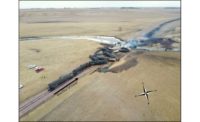Additional information about the rule:
(Unless stated otherwise, the rule applies to “high-hazard flammable trains” (HHFTs)—a continuous block of 20 or more tank cars loaded with a flammable liquid or 35 or more tank cars loaded with a flammable liquid dispersed through a train.).
Enhanced Standards for New and Existing Tank Cars for use in an HHFT—New tank cars constructed after October 1, 2015, are required to meet the new DOT Specification 117 design or performance criteria. The prescribed car has a 9/16 inch tank shell, 11 gauge jacket, 1/2 inch full-height head shield, thermal protection, and improved pressure relief valves and bottom outlet valves. Existing tank cars must be retrofitted with the same key components based on a prescriptive, risk-based retrofit schedule (see table). As a result of the aggressive, risk-based approach, the final rule will require replacing the entire fleet of DOT-111 tank cars for Packing Group I, which covers most crude shipped by rail, within three years and all non-jacketed CPC-1232s, in the same service, within approximately five years.
Enhanced Braking to Mitigate Damage in Derailments—The rule requires HHFTs to have in place a functioning two-way end-of-train (EOT) device or a distributed power (DP) braking system. Trains meeting the definition of a “high-hazard flammable unit train,” or HHFUT (a single train with 70 or more tank cars loaded with Class 3 flammable liquids), with at least one tank car with Packing Group I materials, must be operated with an electronically controlled pneumatic (ECP) braking system by January 1, 2021. All other HHFUTs must have ECP braking systems installed after 2023. This important, service-proven technology has been operated successfully for years in certain services in the United States, Australia, and elsewhere.
Reduced Operating Speeds—The rule restricts all HHFTs to 50 mph in all areas and HHFTs containing any tank cars not meeting the enhanced tank car standards required by this rule are restricted to operating at a 40 mph speed restriction in high-threat urban areas. The 40 mph restriction for HHFTs without new or retrofitted tank cars is also currently required under FRA’s Emergency Order No. 30.
Rail Routing – More Robust Risk Assessment—Railroads operating HHFTs must perform a routing analysis that considers, at a minimum, 27 safety and security factors, including “track type, class, and maintenance schedule” and “track grade and curvature,” and select a route based on its findings. These planning requirements are prescribed in 49 CFR §172.820.
Rail Routing – Improves Information Sharing—Ensures that railroads provide State and/or regional fusion centers, and State, local and tribal officials with a railroad point of contact for information related to the routing of hazardous materials through their jurisdictions. This replaces the proposed requirement for railroads to notify State Emergency Response Commissions (SERCs) or other appropriate state-designated entities about the operation of these trains through their States.
More Accurate Classification of Unrefined Petroleum-Based Products—Offerors must develop and carry out sampling and testing programs for all unrefined petroleum-based products, such as crude oil, to address the criteria and frequency of sampling to improve and ensure accuracy. Offerors must certify that hazardous materials subject to the program are packaged in accordance with the test results, document the testing and sampling program outcomes, and make that information available to DOT personnel upon request.



